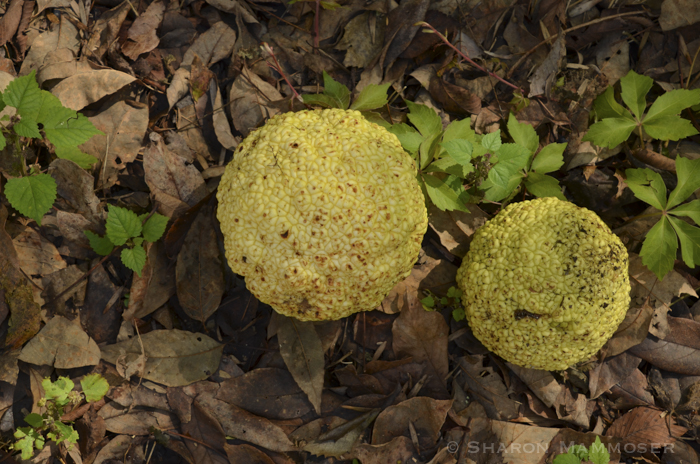I was surprised to see that several people knew the answer to last week’s puzzler–the yellow, brain-like ball the size of a softball. It is the fruit from an Osage Orange (Maclura pomifera) tree. This tree has many common names including hedge apple, prairie hedge, yellowwood, bodark, bois d’arc, and bowwood. The name Osage orange comes from the Osage Indians of Oklahoma and Texas.

The Osage orange tree grows 30-40 feet tall, though it can grow as tall as 60 feet. Its branches have sharp thorns. It was once common throughout the southeastern United States, but now is more limited in its range, found in Texas and neighboring states. Interestingly, no living animal eats the fruit. Scientists believe 10,000 years ago, an extinct animal like a sloth digested and spread the seeds.
It got the nickname hedge apple because, according to the Iowa State University Extension, ” During the mid-nineteenth century, it was widely planted by midwest farmers, including those in southern Iowa, as a living fence. When pruned into a hedge, it provided an impenetrable barrier to livestock. The widespread planting of Osage-orange stopped with the introduction of barbed wire.”
It earned the name bodark–from the French bois d’ arc which means bow wood. This is because the wood of this tree is considered by some to make the best bows. The wood from Osage orange trees is the densest of any tree and the trees can live for 400 years. Native Americans seeking the wood traveled many miles to acquire it and it was highly prized.
Interestingly, I had one blog subscriber tell me that the “oranges” from the Osage orange tree were known to ward off insects and spiders. Having never heard this, I did a little research and indeed, found mention of this. The Iowa State University Extension says “The use of the hedge apples for insect control is one of the most enduring pest management home remedies. Placement of hedge apples around the foundation or inside the basement is claimed to provide relief from cockroaches, spiders, boxelder bugs, crickets and other pests.
The use of hedge apples as a pest solution is communicated as a folk tale complete with testimonials about apparent success. However, there is an absence of scientific research and therefore no valid evidence to confirm the claims of effectiveness. Although insect deterrent compounds have been extracted from hedge apples in laboratory studies, these do not provide a logical explanation about why hedge apples would work as claimed. At this time, there is nothing to recommend the use of hedge apples for pest control.” Like much of the information “out there” about plants and animals, this one seems to be a myth!
According to Mother Earth News, ” the early pioneers considered the Osage orange to be ” a valuable timber resource. Because of its great strength and durability, the settlers used the newly discovered tree in nearly every application that required a tough, tenacious wood.
The hubs and rims of the wheels on farm wagons, covered wagons and chuck wagons were made from Osage. Its great strength enabled it to bear heavy loads, while its flexibility made it relatively easy to bend into the circle of a wheel rim and also gave it the capacity to absorb shock without cracking or splitting. Those properties, added to the wood’s ability to resist the effects of soil and moisture, made for high-mileage wheel rims.”
Now you know!
Here’s the next puzzler, another brain-like ball.

